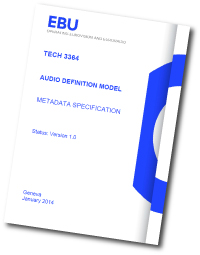
Tech 3364 is the brand new EBU Audio Data Model (ADM), the latest fruit of cooperation between EBU working groups dealing with audio production (SP-FAR) and metadata (SP-MIM).
It can be used with a large variety of audio file formats – such as BWF and RF64 – to provide a complete set of technical and informative metadata that describes the audio content of the file. At first sight this may seem trivial but what it does is to completely unlock file formats to as-yet-unknown audio arrangements and applications. These could, for example, encompass channel-based audio (where numbers such as 1, 2, 5.1, 7.1, 10.1, 22.2 and 15.1 might occur to you), or scene-based, periphonic, binaural or even object-based audio. Tech 3364 can cope with all of these and it will accommodate as-yet-unknown formats by extension of the ADM. It effectively makes the audio file format substantially agnostic to its payload.
An elegant solution
And there's more to it than that. With a complete description of the audio content contained inside the file, the production and replay ends of the content transfer are effectively decoupled; the file is self-declaratory and any intelligent decoding/replay system will be able to perform an optimal rendering of the content.
Put simply, the producer can author content once (e.g. at very high quality, with an immersive audio environment) for replay on a whole variety of reproduction equipment with differing replay capabilities. In this time of restricted production budgets, this is particularly advantageous; broadcasters can keep home theatre and headphone users happy with the same version of the original audio mix.
The definition of an ADM is a fundamental step in paving the way for massively immersive audio environments that will be defined for UHDTV in the coming months. No matter what system is specified, the ADM – perhaps not exactly Tech 3364 Ver. 1.0, but a later iteration of it (it will inevitably be a living document), will provide the key. Pandora’s Box tamed, you might say.
Tech 3364 is available from the EBU Technology & Innovation Publications library.

